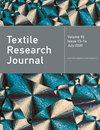Deformation mechanism and mechanical model construction for recycled regenerated silk fibroin/polyvinyl alcohol blended fibers
IF 1.9
4区 工程技术
Q2 MATERIALS SCIENCE, TEXTILES
引用次数: 0
Abstract
The mechanical properties of regenerated silk fibroin-based fibers have attracted much attention, but the related theoretical research and the mechanical model are insufficient. Thus, recycled regenerated silk fibroin (RRSF)/polyvinyl alcohol (PVA) blended as-spun fibers were taken as an example. Transformations of the apparent morphology, microstructure, and two-phase distribution of the as-spun fibers were explored at different tensile stages. The appropriate mechanical models were established with model formulas. The results showed that the RRSF component in the fiber gradually presented an axial fibril-like dispersion and split fragmentary areas under uniform stretching. Then, the PVA component undertook the external force, and ductile fracture finally occurred. At the micro level, the β-sheet content of the RRSF component reached a maximum of 54.7% at 50% elongation. The value of I⊥/I∥ reached the highest point (1.25) when stretched to 100%. The tensile process was divided into low-, negative-, and high-viscoelasticity deformation stages. Nonlinear spring or sticky pot elements were introduced to establish a two-element parallel mechanical model, and the fitting degree of the model formula was higher than 0.993.再生丝素蛋白/聚乙烯醇共混纤维的变形机理及力学模型构建
再生丝素蛋白纤维的力学性能一直备受关注,但相关的理论研究和力学模型还不够完善。因此,以再生丝素蛋白(RRSF)/聚乙烯醇(PVA)共混为纺丝纤维为例。研究了不同拉伸阶段纺丝纤维的表观形态、微观结构和两相分布的变化。用模型公式建立了相应的力学模型。结果表明,在均匀拉伸下,纤维中的RRSF组分逐渐呈现出轴向原纤维状分散,并分裂出碎片区域。然后,PVA组分承受外力,最终发生韧性断裂。在微观层面上,RRSF组分的β-片含量在50%伸长率时达到最大值54.7%。当拉伸到100%时,Iõ/I‖的值达到最高点(1.25)。拉伸过程分为低、负和高粘弹性变形阶段。引入非线性弹簧或粘锅单元建立了二元并联力学模型,模型公式的拟合度大于0.993。
本文章由计算机程序翻译,如有差异,请以英文原文为准。
求助全文
约1分钟内获得全文
求助全文
来源期刊

Textile Research Journal
工程技术-材料科学:纺织
CiteScore
4.00
自引率
21.70%
发文量
309
审稿时长
1.5 months
期刊介绍:
The Textile Research Journal is the leading peer reviewed Journal for textile research. It is devoted to the dissemination of fundamental, theoretical and applied scientific knowledge in materials, chemistry, manufacture and system sciences related to fibers, fibrous assemblies and textiles. The Journal serves authors and subscribers worldwide, and it is selective in accepting contributions on the basis of merit, novelty and originality.
 求助内容:
求助内容: 应助结果提醒方式:
应助结果提醒方式:


